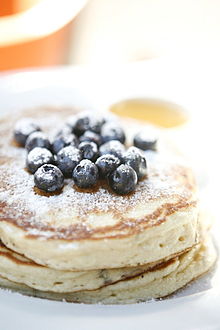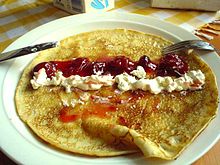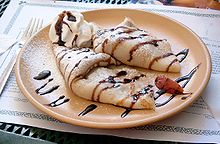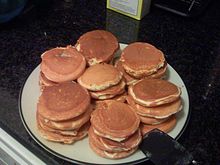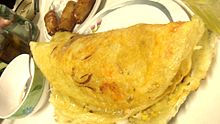- Pancake
-
This article is about the food. For other uses, see Pancake (disambiguation)."Griddle cake" redirects here. For the Irish style bread, see Soda bread.
A pancake is a thin, flat, round cake prepared from a batter, and cooked on a hot griddle or frying pan. Most pancakes are quick breads; some use a yeast-raised or fermented batter. Most pancakes are cooked one side on a griddle and flipped partway through to cook the other side. Depending on the region, pancakes may be served at any time, with a variety of toppings or fillings including jam, chocolate chips, fruit, syrup or meat.
Archaeological evidence suggests that varieties of pancakes are probably the earliest and most widespread types of cereal food eaten in prehistoric societies whereby dry carbohydrate-rich seed flours mixed with the available protein-rich liquids, usually milk and eggs, were baked on hot stones or in shallow earthenware pots over an open fire to form a nutritious and highly palatable foodstuff.[1]
In the medieval and modern Christian period, especially in Britain, pancakes were made to use up store items prior to the period of Lent fasting beginning on Shrovetide.
The pancake's shape and structure varies worldwide. There are numerous variations of them throughout Europe. In Germany, pancakes can be made from potatoes. A crêpe is a Breton variety of thin pancake cooked on one or both sides in a special crepe pan to achieve a network of fine bubbles often compared to lace – a savory variety made from buckwheat is usually known as a galette.
Contents
Etymology
The Middle English word Pancake appears in an English culinary manuscript from 1430.[2][3]
Regional varieties
France
French crêpes, popular in France, Belgium, Switzerland, Canada, and Brazil (where they may be called panquecas or crepes) are made from flour, milk, and eggs. They are thin pancakes and are usually served with a large amount of sweet or savory filling, ranging from fruit or ice cream, to seafood (in Brazil, most usually ground meat). In Francophone Europe, crêpes are often sold in special stands, along with Nutella for topping.
French crêpes have become very popular in many East Asian countries, including Japan, South Korea, The Philippines, Thailand and China, where they are sold in numerous crêpe stands and kiosks. They are often served with whipped cream and fruits, or non-sweet spreads such as various vegetables.
A Breton galette is a large thin pancake made of buckwheat flour, mostly associated with the regions of Normandy and Brittany in France. It is often cooked on one side only.
West Central Europe
German pancakes are called Pfannkuchen (Pfanne and Kuchen meaning 'pan' and 'cake'). In some regions (Berlin, Brandenburg, Saxonia) pancakes are called Eierkuchen, as the term Pfannkuchen refers to Berliners there. In Swabia sliced pancake strips (Flädle) are often served in soup.
Kaiserschmarrn is a light, caramelized pancake that is split into pieces, filled with fruits and/or nuts, sprinkled with powdered sugar and served with a fruit sauce. It is believed that it was first prepared for Kaiser Franz Joseph I of Austria. It is popular in the former Austria-Hungary and Bavaria.
The Netherlands
In the Netherlands, pancakes are called pannenkoeken and eaten at dinnertime. Pancake restaurants are popular at family restaurants and serve many varieties of sweet, savory, and stuffed pancakes. Pannenkoeken are slightly thicker than crêpes and usually quite large (12" or more) in diameter. The batter is egg-based and the fillings can include sliced apples, cheese, ham, bacon, candied ginger and many other ingredients — alone or in combination — as well as "stroop" (molasses), a thick sugar syrup. One classical Dutch filling is a combination of bacon and stroop.
Poffertjes are another Dutch pancake-type dish. They resemble American pancakes somewhat, but are sweeter, and much smaller. The require a specially dimpled pan, preferably in copper. The technique used also varies; they are flipped repeatedly before a side is completely done, in order to attain a softer interior.
Northern Europe
Scandinavian pancakes are similar to the French crêpes. In some of the scandinavian countries they are served with jam as a dessert with a variety of savory fillings. Traditional Swedish variations can be exotic. Beside the usual thin pancakes, called pannkakor, which resembles the French crêpes and, often served with whipped cream and jam, are eaten for lunch on Thursdays with pea soup, the Swedish cuisine has plättar which resemble tiny English pancakes, and are fried several at a time in a special pan. Others resemble German pancakes but include fried pork in the batter; these are baked in the oven. Potato pancakes called raggmunk contain shredded raw potato, and may contain other vegetables (sometimes the pancake batter is omitted, producing rårakor). Raggmunk and rårakor are traditionally eaten with pork rinds and lingonberry jam. A special Swedish pancake is saffron pancake from Gotland, made with saffron and rice, baked in the oven. The Norwegian variety is commonly eaten for dinner, traditionally with different sorts of jams or sugar. It is common to add lemon juice to the sugar for extra taste. The pancakes are often served after a soup. Another special ``Swedish pancake´´ is the äggakaka (eggcake), also called skånsk äggakaka (scanian eggcake),it is almost like an ordinary Swedish pancake but it is a lot thicker and also a lot more difficult to make due to the risk of burning it. It is made in a frying pan and is about 1½ to 2 inches thick and is served with lingonberries and bacon.
Finnish pancakes greatly resemble "Plättar" and are called "Lettu", "Lätty", "Räiskäle" or "Ohukainen". In Finland pancakes are usually eaten as dessert with whipped cream and/or pancake-jam, sugar or vanilla ice-cream. In Finnish, "Lettu" and "Pannukakku" (literally "Pancake") have different meanings, the latter having structurally closer resemblance to hotcake, and baked in an oven instead of using a frying pan. Ålandspannkaka, Pancake of Åland, is an extra thick variety of oven-pancake that includes cardamom and either rice- or semonia porridge to the dough.
Icelandic crepe-like pancakes are called "pönnukaka", and smaller, thicker pancakes resembling North American pancakes are "lumma". The pancakes are usually a bit browner than the traditional Swedish ones. Pönnukaka are usually cooked on a special Icelandic pancake pan, which is made to get the pancake as thin as possible, and after use the pan is rinsed with water but never washed. Pönnukaka are eaten with sugar, but if eaten at a café they might have ice cream instead. In Iceland, North American-style pancakes are cut in half and used as sandwich bread, similar to Icelandic flatbread.
East-Central and Eastern Europe
In Austria, the Czech Republic, and Slovakia pancakes are called palatschinke, palačinka, and palacinka, respectively (plurals palatschinken, palačinky, palacinky). In Romania they are called clătită (plural clătite). In countries of former Yugoslavia (Slovenia, Serbia, Croatia, Macedonia, and Bosnia) they are called palačinka (plural palačinke). In these languages, the word derives from Latin placenta, meaning cake. These pancakes are thin and filled with apricot, plum, lingonberry, strawberry or apple jam, chocolate sauce or hazelnut spread. Eurokrem, Nutella and Lino-Lada fillings are favorite amongst younger population. A traditional version includes filling pancakes with cheese, pouring yoghurt over them and then baking in an oven. Kaiserschmarrn is an Austrian pancake including raisins, almonds, apple jam or small pieces of apple, split into pieces and sprinkled with powdered sugar.
In Hungary, pancakes called palacsinta (also derived from Latin placenta) are made from flour, milk or soda water, sugar and eggs. Sweet wine is added to the batter. The filling is usually jam, sugared and ground walnuts or poppy seeds, sugared cottage cheese, sugared cocoa or cinnamon powder, but – especially in hortobágyi palacsinta – meat and mushroom fillings are also used. Gundel palacsinta is an Hungarian pancake, stuffed with walnuts, zest, raisins and rum, served in chocolate sauce. The dish is often flambéed. Hungarian pancakes are served as a main dish or as a dessert.
In Poland, thin crêpe-style pancakes are called naleśniki (pronounced naleshniki). Like any crêpe or blintz, they can be served with a variety of savory or sweet fillings as a main dish or a dessert. Sweet fillings include fresh fruits (e.g. bilberries), jams, and soft white cheese with sugar. Savory fillings include fried vegetables, fried chicken, minced meat, and a variety of added ingredients such as potatoes, mushrooms, cabbage, or ham. The Polish pancake was adopted by the Russian and the Ukrainian cuisines, which call them nalesniki.[4]
In Belarus, Russia and Ukraine, pancakes may be breakfast food, appetizer, main course, or even dessert. Blintzes (Russian: блинчики blinchiki) are thin crepes made without yeast. Blini (Russian: блины) are thicker pancakes made from wheat or buckwheat flour, butter, eggs, and milk, with yeast added to the batter. Blini cooking has a long history in Russia, dating back to pagan traditions and feasts, which are reflected in today's "pancake week" celebrated in the winter before the Great Lent. Small thick pancakes made from yogurt or buttermilk based batter (without yeast) are called oladyi (оладьи) (diminutive: oladushki оладушки, further abbreviated as ladushki ладушки).
United Kingdom and Ireland
 Scottish pancake and fruit pikelet
Scottish pancake and fruit pikelet
English pancakes have three key ingredients: plain flour, eggs, and milk. The batter is runny and forms a thin layer on the bottom of the frying pan when the pan is tilted. It may form some bubbles during cooking, which results in a pale pancake with dark spots where the bubbles were, but the pancake does not rise. English pancakes are similar to French crêpes, and Italian crespelle, but are not "lacy" in appearance. They may be eaten as a sweet dessert with the traditional topping of lemon juice and sugar, drizzled with golden syrup, or wrapped around savory stuffings and eaten as a main course. On Shrove Tuesday, it is custom to eat pancakes, when lemon juice may be added to top the pancake. Yorkshire pudding is made from a similar recipe, but baked instead of fried. This batter rises because the air beaten into the batter expands, without the need for baking powder; the result is eaten as part of the traditional roast beef dinner. Oatcakes are a savory variety of pancake particularly associated with Staffordshire.
Scottish pancakes (often known as scotch pancakes) are more like the American type and are served as such. In Scotland they are also referred to as drop scones or dropped scones.[5][6][7] They are made from flour, eggs, sugar, buttermilk or milk, salt, bicarbonate of soda and cream of tartar.[5][6][7] Smaller than American or English pancakes at about 3.5 in / 9 cm in diameter, they are made by the traditional method of dropping batter onto a griddle (a girdle in Northumberland or in Scots). They can be served with jam and cream or just with butter. In Scotland pancakes are generally served at teatime.
Welsh pancakes (known as crempog, ffroes and other names) vary considerably. Some are very much like American pancakes, others may be made with yeast (called crempog furum) or oatmeal (although this is also true of American pancakes) and some are like Scottish pancakes.[8][9]
Crumpets and pikelets are sometimes considered a variety of pancake.
North America
American or Canadian pancakes (sometimes called hotcakes, griddlecakes, or flapjacks) are pancakes that contain a raising agent such as baking powder; proportions of eggs, flour, and milk or buttermilk create a thick batter. Many recipes remind the reader that the ingredients should be mixed until they are just combined, even if lumps remain, as the lumps will smoothen out during the cooking process.[10][11] Sugar and spices such as cinnamon, vanilla and nutmeg are sometimes added. The pancakes can be made sweet or savory by adding ingredients such as blueberries, strawberries, cheese, bananas, apples or chocolate chips to the batter. This batter is ladled or poured onto a hot surface, and spreads to form a circle about ¼ or ⅓ inch (1 cm) thick. The raising agent causes bubbles to rise to the uncooked side, before the pancake is flipped. These pancakes, very light in texture, are usually served at breakfast topped with maple syrup, butter, jam, peanut butter, nuts, fruit and/or honey. Pancakes may be served with a bit of powdered sugar and whipped cream, or with cane syrup or molasses instead of syrup or honey. Some pancake recipes use yogurt to give the pancakes a semi-thick, relatively moist consistency.
Jonnycake (also spelled "johnnycake," johnny cake, and "journey cake") or Johnny Bread is a cornmeal flatbread that was an early American staple food, and is still eaten in the West Indies and Bermuda.[12] The modern johnnycake is stereotypically identified with today's "Rhode Island" foods, though jonnycakes are a cultural staple in all of the northern US.[13] A modern jonnycake is fried cornmeal gruel, which is made from yellow or white cornmeal mixed with salt and hot water or milk, and frequently lightly sweetened.
Yaniqueques or yanikeke are a Dominican Republic version of the jonnycake. They are a fried bread rather than a pancake and are a popular beach food.[14][15]
Sourdough was used by prospectors and pioneers to make sourdough pancakes without having to buy yeast. Prospectors would carry a pot of sourdough to make pancakes and bread as it could last indefinitely, needing only flour and water to replenish it.[16] Sourdough pancakes are now a particular speciality in Alaska.[17]
A flapjack is a thick small pancake, generally around 10 cm in diameter. Flapjacks are often served in a stack with syrup and butter, which can be accompanied by bacon. The terms pancake and flapjack are often confused and today in the US are nearly synonymous. The Oxford English Dictionary records the word flapjack as being used as early as the beginning of the 17th century, referring to a flat tart or pan-cake. Shakespeare refers to pancakes in All's Well That Ends Well and to flap-jacks in Pericles, Prince of Tyre:[18]
- "Come, thou shant go home, and we'll have flesh for holidays, fish for fasting-days, and moreo'er puddings and flap-jacks, and thou shalt be welcome."
- Act II Scene I
The word elements: flap- meaning a tossed mixture and jack, an uncertain word suggesting a variety, imply any ingredients could be called a flapjack.
A silver dollar pancake refers to a pancake about two to three inches (5 to 7 cm) in diameter, or just a bit bigger than the pre-1979 silver dollar coins in the United States, for which they are named. It is usually made by frying a small spoonful of the same batter as any other pancake. One serving is usually five to ten silver dollar pancakes.
German Pancakes or Dutch baby pancakes served in American pancake houses are bowl-shaped. They are eaten with lemons and powdered sugar, jam, or caramelized apples, as well as fritters. A David Eyre's pancake is a variation on the German pancake named for the American writer and editor David W. Eyre (1912–2008).
Mexican hotcakes are similar to US pancakes. Hotcakes are often made with cornmeal — as well as, or instead of wheat flour. Hotcakes are popular breakfast items at restaurants throughout the country, and are often sold by street vendors in cities and during the local celebrations of towns through the day; the vendors sell a single hotcake topped with different sauces such as condensed milk, fruit jam or a sweet goat milk spread called "cajeta".
Guatemalan pancakes are called Panqueques. They are made with the same ingredients as US pancakes. The toppings are usually fruits and honey. They are a very popular breakfast meal in Guatemala. Depending on where you are in the country, the "Panqueque" can be thin as a "Crêpe" or as fluffy as a North American pancake.
Asia
 Uttapam, an Indian style pancake.
Uttapam, an Indian style pancake.
 Dosa, prepared and served at a restaurant in India.
Dosa, prepared and served at a restaurant in India.
Banana pancakes are a menu item in Western-oriented backpackers' cafes in Asian countries such as Thailand, Cambodia, Vietnam, India, and China. This has elicited the term Banana Pancake Trail.
Chinese pancakes may be either savory or sweet, and are generally made with dough rather than batter.
In India the Pooda (sometimes called Cheela) is a pancake. They can be made either sweet or salty and are of different thicknesses in different places. They are made in a frying pan and are of a similar batter as their European counterparts
Dosa, Appam, Neer dosa and Uttapam could be said to be other Indian pancakes. They are prepared by fermenting rice batter and split skinned urad bean (black lentil) blended with water. What Punjabis call a meetha pooda are a common breakfast food item in the Punjab. It is a sweet pancake which can be eaten with pickles and chutney. Most of the pithas in Assam are types of pancakes served on occasions such as Bihu. In most parts of India there is a sweet pancake called malpua served.
The Indonesian pancake serabi is made from rice flour and coconut milk.
In Japan, okonomiyaki are made from flour, egg, cabbage and a choice of ingredients.
In Korea, pancakes include jeon, pajeon, bindaetteok, kimchijeon, and hotteok.
In Malaysia and Singapore, There is also another version, eaten by Malays, called apam balik which replaces the filling with sweet corn and condensed milk.
In Nepal, the Newar have a savory rice pancake called chataamari cooked with meat or eggs on top. In the Philippines, pancakes or "hotcakes" are also served with syrup (maple or imitation corn syrup) margarine and sugar or condensed milk. They are served for breakfast, but there are street stalls that sell smaller hotcakes topped with margarine and sugar as an afternoon snack.
In Vietnamese cuisine there is a variety of traditional pancakes; these include bánh xèo and bánh khọt in southern Vietnam, and bánh căn and bánh khoái in central Vietnam.
Australia
In Australia and New Zealand, small pancakes (about 75 mm in diameter), known as pikelets are also eaten. They are traditionally served with jam and/or whipped cream, or solely with butter, at afternoon tea. However, they are also common at morning tea. They are made with milk, self-raising flour, eggs and a small amount of icing sugar.[citation needed]
In some circles in New Zealand, very thin, crêpe-like or UK pancake-like pancakes (around 20 cm in diameter), are known as "flapjacks". This may refer to their thinness, making them more likely to "flap". They are traditionally served with butter, or butter and lemon, possibly something sweet, and then rolled up and eaten.[citation needed]
American style pancakes are also popular in Australasia. They are eaten for breakfast or as a dessert, with lemon juice and sugar, butter and maple syrup, stewed fruits such as strawberries and cream, ice cream or mascarpone.[citation needed]
Africa
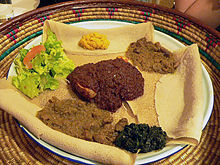 This meal, consisting of injera and several kinds of wat or tsebhi (stew), is typical of Ethiopian and Eritrean cuisine.
This meal, consisting of injera and several kinds of wat or tsebhi (stew), is typical of Ethiopian and Eritrean cuisine.
"Pancakes" in the Horn of Africa region (Djibouti, Eritrea, Ethiopia, and Somalia) are known as injera (sometimes transliterated enjera; Oromo: budenaa; Somali: canjeero). Injera is a yeast-risen flatbread with a unique, slightly spongy texture. Traditionally made out of teff flour, it is a national dish in Ethiopia and Eritrea. A similar variant is eaten in Somalia (where it is called canjeero or lahooh) and Yemen (where it is known as lahoh). In Eritrea and Ethiopia, a variety of stews, sometimes salads (during Ethiopian Orthodox fasting, for which believers abstain from most animal products) or simply more injera (called injera firfir), are placed upon the injera for serving. Using one's right hand, small pieces of injera are torn and used to grasp the stews and salads for eating. The injera under these stews soaks up the juices and flavours of the foods and, after the stews and salads are gone, this bread is also consumed. Injera is thus simultaneously food, eating utensil, and plate. When the entire "tablecloth" of injera is gone, the meal is over.
Pancakes in South Africa refer to crepes. They are traditionally prepared by the Afrikaans community on gas stoves, and called a pannekoek in Afrikaans, eaten on wet and cold days. Pannekoeke are served with cinnamon-flavored sugar (and sometimes lemon juice); the sugar may be left to dissolve onto the pancake; if eaten immediately the pancake is crispy. It is a staple at Dutch Reformed Church fetes.[19] American-style "silver dollar" pancakes are eaten in South Africa, as "plaatkoekies" or "flapjacks". In South Africa, there is a variation of the pancake called a crumpet. It is made from self-raising flour, eggs, milk and a pinch of salt. The smooth batter is fried in butter resulting in a slightly raised flat cake. Crumpets are always served hot, usually for breakfast, with butter and golden syrup.
In Kenya, pancakes are eaten for breakfast as an alternative to bread. They are served plain with the sugar already added to the batter to sweeten them. Kenyan pancakes are similar to English pancakes and French crepes. In Uganda, pancakes are locally made with bananas (one of the staple foods of the country) and usually served as a breakfast or as a snack option.
Pancake restaurant chains
In the US, Mexico and Canada, a franchised restaurant chain named International House of Pancakes (IHOP) has restaurants serving pancakes at all hours of the day. The Original Pancake House is another chain of pancake restaurants across the US, and Walker Brothers is a series of pancake houses in the Chicago area that developed as a franchised spin-off of The Original Pancake House.
The popularity of pancakes in Australia has spawned the Pancake Parlour and Pancakes on the Rocks franchised restaurants. In British Columbia and Alberta, the restaurant chain De Dutch serves Dutch and Flemish-style pannenkoeken.
Pancake Day
Main article: Shrove TuesdayIn Canada,[20] the United Kingdom,[21] Ireland,[22] New Zealand, and Australia,[23] pancakes are traditionally eaten on Shrove Tuesday, which is also known as "Pancake Day" and, particularly in Ireland, as "Pancake Tuesday". (Shrove Tuesday is better known in the United States, France and other countries as Mardi Gras or Fat Tuesday.) Historically, pancakes were made on Shrove Tuesday so that the last of the fatty and rich foods could be used up before Lent.
Charity and school events are organized on Pancake Day: in a "pancake race" each participant carries a pancake in a frying pan. All runners must toss their pancakes as they run and catch them in the frying pan. This event is said to have originated in Olney, England in 1444 when a housewife was still busy frying pancakes to eat before the Lenten fast when she heard the bells of St Peter and St Paul's Church calling her to the Shriving Service. Eager to get to church, she ran out of her house still holding the frying pan complete with pancake, and still wearing her apron and headscarf.[citation needed] Pancake Day is widely celebrated in Australia.
Every Shrove Tuesday since 1950 the towns of Olney[24] and Liberal, Kansas have competed in the International Pancake Race. Only local women may compete; they race, and their times are compared to determine the international winner. In Olney the main women's race is augmented by races for local schoolchildren and for men.
The Rehab UK Parliamentary Pancake Race takes place every Shrove Tuesday, with teams from the British lower house (the House of Commons), the upper house (the House of Lords), and the Fourth Estate, contending for the title of Parliamentary Pancake Race Champions. The fun relay race is to raise awareness of the work of the national brain injury charity, Rehab UK, and the needs of people with acquired brain injury. In 2009, the Lords won.[25] The race was won by the Lower House in 2010, before the Upper House reclaimed the title in 2011.[25]
See also
- Banana Pancake Trail
- Bánh xèo
- Bindaetteok
- Blintz
- Dorayaki
- French Toast
- Injera
- Johnnycake
- Okonomiyaki
- Pannekoek
- Qistibi
- Waffle
References
Notes
- ^ Jones, M. Feast; Why Humans share food, Oxford University Press, 2007
- ^ Pancake History Pancakeology
- ^ Online Etymology Dictionary
- ^ Nalesniki in V.V. Pokhlebkin's Culinary Dictionary, 2002 (Russian)
- ^ a b McNeill, F. Marian (1929). The Scots Kitchen. Paperback: 259 pages, Edinburgh: Mercat Press; New Ed edition (25 October 2004) ISBN 1-84183-070-4, p179
- ^ a b Maw Broon (2007). Maw Broon's Cookbook. Waverley Books; (18 October 2007) ISBN 1-902407-45-8, p131
- ^ a b S.W.R.I. (1977). S.W.R.I. Jubilee Cookery Book. Edinburgh: Scottish Women's Rural Institutes; Reprint of 8th Edition (1968), p117
- ^ Freeman, Bobby First catch your peacock: her classic guide to Welsh food Y Lolfa; New edition edition (30 October 2006) ISBN 978-0-86243-315-4 pp.195–196 Google Books
- ^ Tibbit, Sara Minwell Baking in Wales National Museums and Galleries of Wales (December 1991) ISBN 978-0-7200-0346-8 p.13 Google Books
- ^ Example: Cookingforengineerse.com
- ^ Example: Wiki page on how to make pancakes
- ^ Darwin Porter, Danforth Prince, Frommer's 2010 Bermuda Excerpt at Google Books
- ^ New England Country Store Cookbook by Peter W. Smith (iUniverse 2003)
- ^ Uribie, Millizen "Creole Cravings" Hoy Digital 25 February 2010
- ^ "Yaniqueques: food and security" DR1 11 December 2008
- ^ Ridgwell, Jenny Finding Out About Food Oxford University Press Oxford (30 June 1983) ISBN 978-0-19-832716-5 p.89
- ^ DuFresne, Jim; Aaron Sprizter Alaska Lonely Planet Publications; 6th Revised edition edition (1 April 2006) ISBN 978-1-74059-991-7 p.40
- ^ Thiselton, T.F> Folklore of Shakespeare Kessinger Publishing Co (11 January 2004) ISBN 978-0-7661-8308-7 p.281 Google Books
- ^ Boer op ons werf Landbou.com
- ^ "The Presbyterian Church in Canada" (PDF). The Presbyterian Church in Canada. http://www.presbyterian.ca/webfm_send/1974.
- ^ "Pancake Day (Shrove Tuesday), in the UK". British Embassy, Washington DC. Archived from the original on 23 February 2007. http://web.archive.org/web/20070223204148/http://www.britainusa.com/sections/articles_show_nt1.asp?d=0&i=60062&L1=0&L2=0&a=41276. Retrieved 17 November 2006.
- ^ "Shrove Tuesday – Pancake Day!". Irish Culture and Customs. http://www.irishcultureandcustoms.com/ACalend/ShroveTues.html. Retrieved 17 November 2006.
- ^ "Easter in Australia". The Australian Government Culture and Recreation Portal. http://www.cultureandrecreation.gov.au/articles/easter/. Retrieved 17 November 2006.
- ^ Olney Pancake Race 2007 Video
- ^ a b Peers batter MPs in pancake race, BBC News, 24 February 2009, http://news.bbc.co.uk/1/hi/uk_politics/7908437.stm, retrieved 18 May 2009
Further reading
- Albala, Ken (2008). Pancake: A Global History. Reaktion Books. p. 128. ISBN 9781861893925.Uchicago.edu
External links
- History of the Olney, England pancake race
- History of the pancake foodtimeline.org
- Video: "Blueberry Pancake Showdown", Throwdown! with Bobby Flay, January 2009
Pancakes Types Æbleskiver • Appam • Bánh cuốn • Bánh xèo • Bannock • Blintz • Boûkète • Boxty • Cachapa • Chalboribbang • Chapati • Chataamari • Chinese pancake • Crempog • Crêpe • Dosa • Dutch baby pancake • Eggette • Farinata • Flädle • Fläskpannkaka • Funkaso • Galette • Hirayachi • Hortobágyi palacsinta • Injera • Jeon • Jonnycake • Khanom bueang • Memela • Memiljeon • Mofletta • Murtabak • Nalesniki • Oatcake • Okonomiyaki • Palatschinke • Pannekoek • Pathiri • Pesarattu • Ploye • Poffertjes • Potato pancake • Quarkkäulchen • Rava dosa • Roti prata • Sel roti • Socca • Spring pancake • Suncake • Serabi • Thalipeeth • Tlacoyo • Touton • UttapamBrands  Book:Crêpes, pancakes, and waffles ·
Book:Crêpes, pancakes, and waffles ·  Category:Pancakes ·
Category:Pancakes ·  Portal:FoodCategories:
Portal:FoodCategories:- Breakfast foods
- Pancakes
- World cuisine
- American cuisine
- British cuisine
- Canadian cuisine
- Vermont cuisine
- Mardi Gras food
- Fast food
- "Come, thou shant go home, and we'll have flesh for holidays, fish for fasting-days, and moreo'er puddings and flap-jacks, and thou shalt be welcome."
Wikimedia Foundation. 2010.

